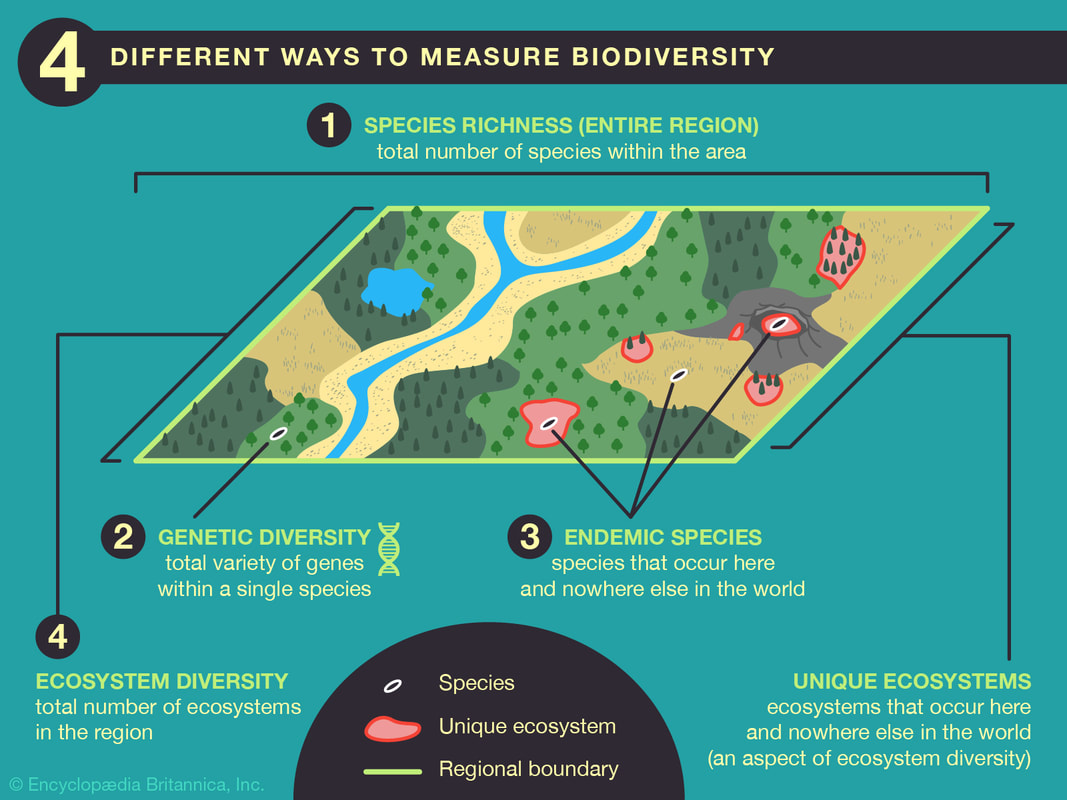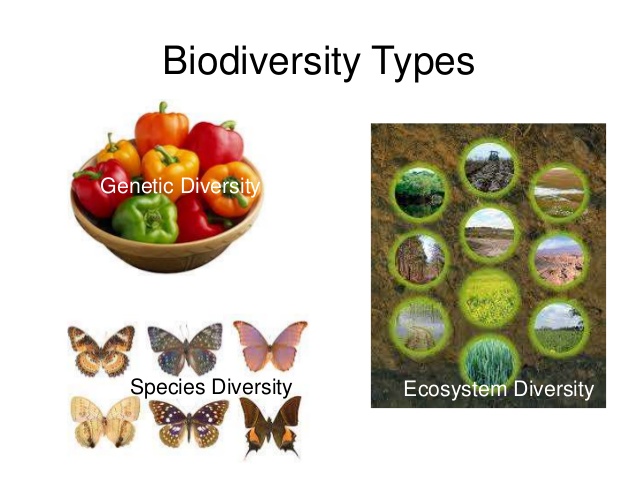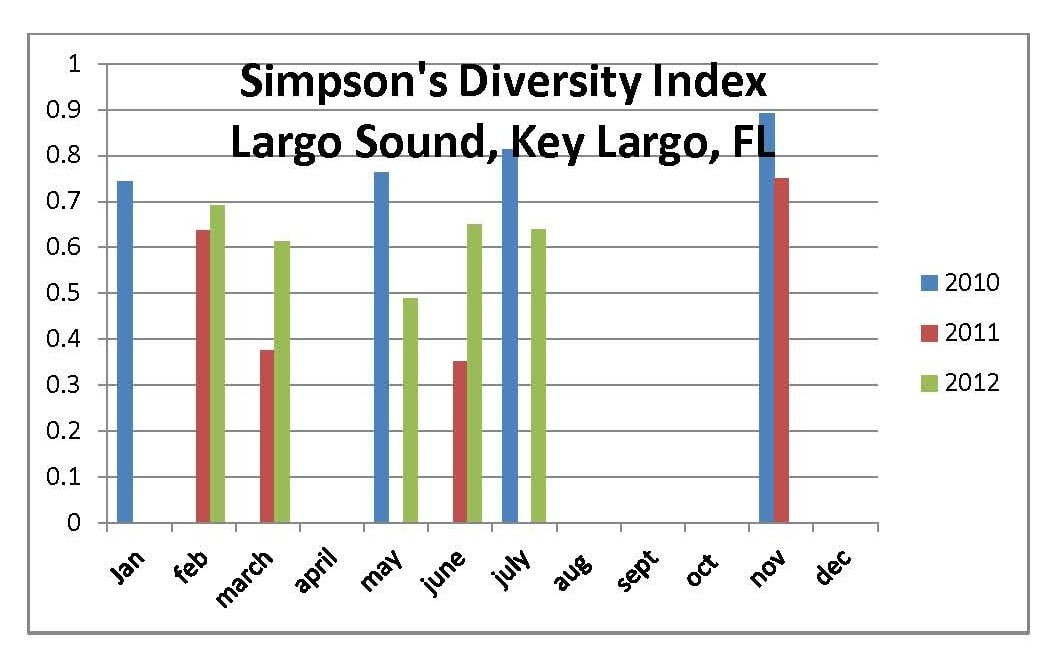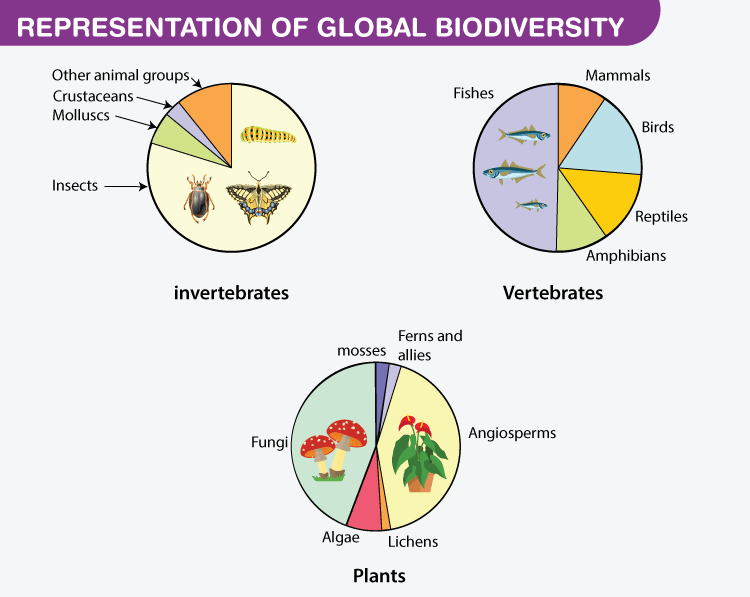topic 3.1: Introduction to biodiversity
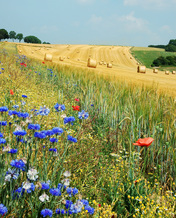
Biodiversity is the variety of all life forms on earth - the different plants, animals and micro-organisms and the ecosystems of which they are a part.
In this unit we will see how diversity changes through succession, genetic diversity, limiting factors and human activities.
This unit is a minimum of 2 hours,
In this unit we will see how diversity changes through succession, genetic diversity, limiting factors and human activities.
This unit is a minimum of 2 hours,
Significant Ideas
- Biodiversity can be identified in a variety of forms, including species diversity, habitat diversity and genetic diversity.
- The ability to both understand and quantify biodiversity is important to conservation efforts
Big questions:
- How are issues addressed in this topic of relevance to sustainability or sustainable development
- In what ways might the solutions explored in this topic alter our predictions for the state of human societies and the biosphere some decades from now?
- Unsustainable development can lead to species extinction. Given the five mass extinctions of the past, is this something that the human race should be concerned about?
- What effects could species extinctions have on human societies in years to come?
Knowledge & Understanding:
3.1.U1 Biodiversity is a broad concept encompassing the total diversity of living systems, which includes the diversity of species, habitat diversity and genetic diversity.
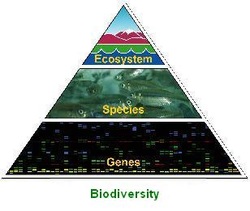
The term biodiversity refers to the variety of life on Earth at all its levels, from genes to ecosystems, and the ecological and evolutionary processes that sustain it. Biodiversity includes not only species we consider rare, threatened, or endangered, but every living thing—even organisms we still know little about, such as microbes, fungi, and invertebrates. Biodiversity is important everywhere; species and habitats in your area as well as those in distant lands all play a role in maintaining healthy ecosystems.
3.1.U2 Species diversity in communities is a product of two variables: the number of species (richness) and their relative proportions (evenness)
[Species diversity within a community sis a component of the broader description of the biodiversity of an entire ecosystem]
[Species diversity within a community sis a component of the broader description of the biodiversity of an entire ecosystem]
- Define species diversity
- Compare species richness and evenness
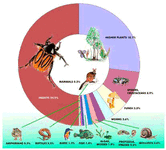 image from friendsberowravalley.org.au
image from friendsberowravalley.org.au
Species diversity is defined as the number of species and abundance of each species that live in a particular location. The number of species that live in a certain location is called species richness.
Richness is a measure of the number of different species in an area; more species means a richer environment. However, no account is taken of how common or rare each species is.
Evenness looks at the relative abundance of the species. It therefore takes into account the abundance or scarcity of each species and eliminates the problems of just analysing species richness in an area.
If you were to measure the species richness of a forest, you might find 20 bird species, 50 plant species, and 10 mammal species. Abundance is the number of individuals of each species. For example, there might be 100 mountain beavers that live in a forest. You can talk about species diversity on a small scale, like a forest, or on a large scale, like the total diversity of species living on Earth
Richness is a measure of the number of different species in an area; more species means a richer environment. However, no account is taken of how common or rare each species is.
Evenness looks at the relative abundance of the species. It therefore takes into account the abundance or scarcity of each species and eliminates the problems of just analysing species richness in an area.
If you were to measure the species richness of a forest, you might find 20 bird species, 50 plant species, and 10 mammal species. Abundance is the number of individuals of each species. For example, there might be 100 mountain beavers that live in a forest. You can talk about species diversity on a small scale, like a forest, or on a large scale, like the total diversity of species living on Earth
3.1.U3 Communities can be described and compared through the use of diversity indices. When comparing communities that are similar, low diversity could be indicative of pollution, eutrophication or recent colonization of a site. The number of species present in an area is often indicative of general patterns of biodiversity
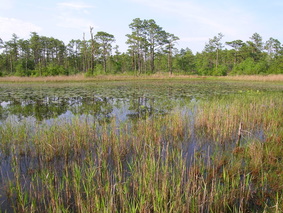
A diversity index is a mathematical measure of species diversity in a community.
Diversity indices provide more information about community composition than simply species richness (i.e., the number of species present); they also take the relative abundances of different species into account.
Diversity indices provide important information about rarity and commonness of species in a community. The ability to quantify diversity in this way is an important tool for biologists trying to understand community structure.
Simpson's diversity index (D) is a simple mathematical measure that characterizes species diversity in a community
Diversity indices provide more information about community composition than simply species richness (i.e., the number of species present); they also take the relative abundances of different species into account.
Diversity indices provide important information about rarity and commonness of species in a community. The ability to quantify diversity in this way is an important tool for biologists trying to understand community structure.
Simpson's diversity index (D) is a simple mathematical measure that characterizes species diversity in a community
3.1.U4 Habitat diversity refers to the range of different habitats in an ecosystem or biome.
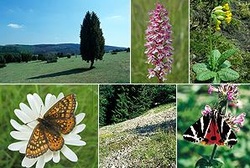
Habitat diversity is often associated with the variety of ecological niches
Habitat diversity is made up of several components. Perhaps the most easily recognized component of habitat diversity is vegetative diversity.
Vegetative diversity refers to the number of different species of vegetation present. The greater the number of species, the greater the vegetative diversity.
Diverse plant communities increase the likelihood that some of the plants that serve as required food and cover species for a particular wildlife species are present. A woodland may contain many different habitats (e.g. river, soil, trees) and so have a high habitat diversity, whereas a desert has few (e.g. sand, occasional vegetation) and so has a low habitat diversity.
Habitat diversity is made up of several components. Perhaps the most easily recognized component of habitat diversity is vegetative diversity.
Vegetative diversity refers to the number of different species of vegetation present. The greater the number of species, the greater the vegetative diversity.
Diverse plant communities increase the likelihood that some of the plants that serve as required food and cover species for a particular wildlife species are present. A woodland may contain many different habitats (e.g. river, soil, trees) and so have a high habitat diversity, whereas a desert has few (e.g. sand, occasional vegetation) and so has a low habitat diversity.
3.1.U5 Genetic diversity refers to the range of genetic material present in a population of a species.
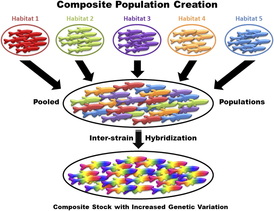 image from www.shareyouressays.com
image from www.shareyouressays.com
Each individual species possesses genes which are the source of its own unique features: In human beings, for example, the huge variety of people's faces reflects each person's genetic individuality.
The term genetic diversity also covers distinct populations of a single species, such as the thousands of breeds of different dogs or the numerous variety of roses.
Gene pool refers to all the different types of gene found within every individual of a species. A large gene pool leads to high genetic diversity and a small gene pool to low genetic diversity. Although the term normally refers to the diversity within one species, it can also be used to refer to the diversity of genes in all species within an area.
While some individuals might be able to tolerate an increased load of pollutants in their environment, others, carrying different genes, might suffer from infertility or even die under the exact same environmental conditions. Whilst the former will continue to live in the environment the latter will either have to leave it or die. This process is called natural selection and it leads to the loss of genetic diversity in certain habitats. However, the individuals that are no longer present might have carried genes for faster growth or for the ability to cope better with other stress factors.
The term genetic diversity also covers distinct populations of a single species, such as the thousands of breeds of different dogs or the numerous variety of roses.
Gene pool refers to all the different types of gene found within every individual of a species. A large gene pool leads to high genetic diversity and a small gene pool to low genetic diversity. Although the term normally refers to the diversity within one species, it can also be used to refer to the diversity of genes in all species within an area.
While some individuals might be able to tolerate an increased load of pollutants in their environment, others, carrying different genes, might suffer from infertility or even die under the exact same environmental conditions. Whilst the former will continue to live in the environment the latter will either have to leave it or die. This process is called natural selection and it leads to the loss of genetic diversity in certain habitats. However, the individuals that are no longer present might have carried genes for faster growth or for the ability to cope better with other stress factors.
3.1.U6 Quantification of biodiversity is important to conservation efforts so that areas of high biodiversity may be identified, explored, and appropriate conservation put in place where possible.
The ability to assess changes to biodiversity in a given community over time is important in assessing the impact of human activity in the community
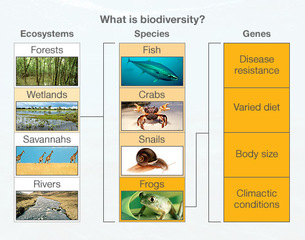 image from www.bbc.co.uk
image from www.bbc.co.uk
Conservation means ‘keeping what we have’. Conservation aims to protect habitats and ecosystems, and hence species from human-made disturbances, such as deforestation and pollution. Conservation activities aim to slow the rate of extinction caused by the knock-on effects of unsustainable exploitation of natural resources and to maintain biotic interactions between species
Biodiversity in a given area is dependent on many different parameters and the interrelationships between these factors.
A complex ecosystem with its variety of nutrient and energy pathways provides stability. Stability lead to diversity.
Succession increases species diversity as there are new habitats been formed and a more complex ecosystem had been formed.
Human activities modify succession, for example, logging, grazing, burning
Greater habitat diversity leads to greater species and genetic diversity
An ecosystem’s capacity to survive change may depend on diversity, resilience(how well the system can return to the starting position) and inertia (how hard it is to move the system to a new position)
Human activities often simplify ecosystems, rendering them unstable
Examples:
Biodiversity in a given area is dependent on many different parameters and the interrelationships between these factors.
- diversity changes through succession
- greater habitat diversity leads to greater species and genetic diversity
- a complex ecosystem, with its variety of nutrient and energy pathways, provides stability
- human activities modify succession, for example, logging, grazing, burning
- human activities often simplify ecosystems, rendering them unstable, for example, North America wheat farming versus tall grass prairie
- an ecosystem’s capacity to survive change may depend on diversity, resilience and inertia.
A complex ecosystem with its variety of nutrient and energy pathways provides stability. Stability lead to diversity.
Succession increases species diversity as there are new habitats been formed and a more complex ecosystem had been formed.
Human activities modify succession, for example, logging, grazing, burning
Greater habitat diversity leads to greater species and genetic diversity
An ecosystem’s capacity to survive change may depend on diversity, resilience(how well the system can return to the starting position) and inertia (how hard it is to move the system to a new position)
Human activities often simplify ecosystems, rendering them unstable
Examples:
- Tropical forests -high diversity and inertia, low resilience – thin soils
- Grasslands - low diversity and inertia, high resilience – rich soils.
3.1.U7 The ability to assess changes to biodiversity in a given community over time is important in assessing the impact of human activity in the community
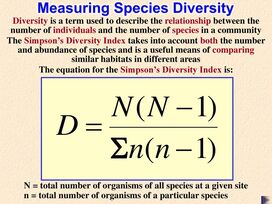
A key tool used by conservation biologists to assess the effect of disturbance is use of diversity indices, such as the Simpson’s index.
Quantification of biodiversity in this way is important to conservation efforts so that areas of high biodiversity are identified, explored, and appropriate conservation put in place where possible.
Areas that are high in biodiversity are known as hotspots. They contain large numbers of endemic species (species not found anywhere else), and so measures of biodiversity are essential in identifying areas that should be protected against damaging human activities
Measurements of species richness, on their own, are not sufficient to establish the impacts of human activities. Assessment of species richness varies according to sampling technique
Quantification of biodiversity in this way is important to conservation efforts so that areas of high biodiversity are identified, explored, and appropriate conservation put in place where possible.
Areas that are high in biodiversity are known as hotspots. They contain large numbers of endemic species (species not found anywhere else), and so measures of biodiversity are essential in identifying areas that should be protected against damaging human activities
Measurements of species richness, on their own, are not sufficient to establish the impacts of human activities. Assessment of species richness varies according to sampling technique
Application & Skills
3.1.A1 Distinguish between biodiversity, diversity of species, habitat diversity and genetic diversity.
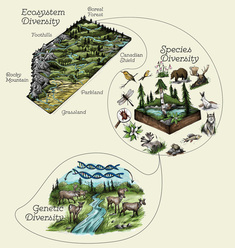 image from www.abmi.ca
image from www.abmi.ca
Biodiversity: The amount of biological or living diversity per unit area. It includes the concepts of species diversity, habitat diversity and genetic diversity.
This is the total number of species living in an ecosystem. Recently attention has been focused on global biodiversity and the extinction of species due to human activities.
Researchers have estimated that there are between 3 - 30 million species on Earth, with a few studies predicting that there may be over 100 million species on Earth! Currently, we have identified only 1.7 million species, so we have a long way to go before we can come close to figuring out how many species are on Earth!
There is more biodiversity within tropical ecosystems than temperate or boreal ecosystems. Tropical rainforests have the most diversity.
The most diverse group of animals are invertebrates. Invertebrates are animals without backbones, including insects, crustaceans, sponges, scorpions and many other kinds of organisms. Over half of all the animals already identified are invertebrates. Beetles are some of the most numerous species.
Science has so much more to learn about the biodiversity of microscopic organisms like bacteria and protozoa.
It is impossible to know how many species actually exist for following reasons:
- genetic diversity: the genetic range that is present in a population of a species. Species that have a small genetic diversity are more at risk of being wiped out by diseases. Selective breeding by humans to domesticate animals or grow plants with specific traits has reduced the gene pool in many species.
- species diversity: the range of species living in a specified area. An area may have a high density of wildlife, but if they are all from a few different species then it would have a low species diversity.
- habitat diversity: the range of different habitats in an ecosystem. Jungle or forest ecosystems are likely to have a higher habitat diversity than desert or tundra ecosystems.
This is the total number of species living in an ecosystem. Recently attention has been focused on global biodiversity and the extinction of species due to human activities.
Researchers have estimated that there are between 3 - 30 million species on Earth, with a few studies predicting that there may be over 100 million species on Earth! Currently, we have identified only 1.7 million species, so we have a long way to go before we can come close to figuring out how many species are on Earth!
There is more biodiversity within tropical ecosystems than temperate or boreal ecosystems. Tropical rainforests have the most diversity.
The most diverse group of animals are invertebrates. Invertebrates are animals without backbones, including insects, crustaceans, sponges, scorpions and many other kinds of organisms. Over half of all the animals already identified are invertebrates. Beetles are some of the most numerous species.
Science has so much more to learn about the biodiversity of microscopic organisms like bacteria and protozoa.
It is impossible to know how many species actually exist for following reasons:
- We have not explored every part of the biosphere yet.
- Most species are less than 1mm long so they are easily overlooked.
- Apart from the popular taxonomic groups like birds and mammals there are not enough experts to identify the more obscure and "esoteric" groups.
- Species become extinct before they have been discovered.
3.1.A2 Comment on the relative values of biodiversity data.
[Interpreting diversity is complex; low diversity can be present in natural; ancient and unpolluted sites]
[Interpreting diversity is complex; low diversity can be present in natural; ancient and unpolluted sites]
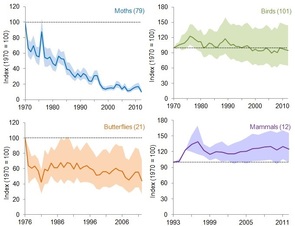 image from jncc.defra.gov.uk
image from jncc.defra.gov.uk
In spite of many tools and data sources, biodiversity remains difficult to quantify precisely. But precise answers are seldom needed to devise an effective understanding of where biodiversity is, how it is changing over space and time, the drivers responsible for such change, the consequences of such change for ecosystem services and human well-being, and the response options available.
Ideally, to assess the conditions and trends of biodiversity either globally or sub-globally, it is necessary to measure the abundance of all organisms over space and time, using taxonomy (such as the number of species), functional traits (for example, the ecological type such as nitrogen-fixing plants like legumes versus non-nitrogen-fixing plants), and the interactions among species that affect their dynamics and function (predation, parasitism, competition, and facilitation such as pollination, for instance, and how strongly such interactions affect ecosystems).
Even more important would be to estimate turnover of biodiversity, not just point estimates in space or time
Ideally, to assess the conditions and trends of biodiversity either globally or sub-globally, it is necessary to measure the abundance of all organisms over space and time, using taxonomy (such as the number of species), functional traits (for example, the ecological type such as nitrogen-fixing plants like legumes versus non-nitrogen-fixing plants), and the interactions among species that affect their dynamics and function (predation, parasitism, competition, and facilitation such as pollination, for instance, and how strongly such interactions affect ecosystems).
Even more important would be to estimate turnover of biodiversity, not just point estimates in space or time
3.1.A3 Discuss the usefulness of providing numerical values of species diversity to understanding the nature of biological communities and the conservation of biodiversity.
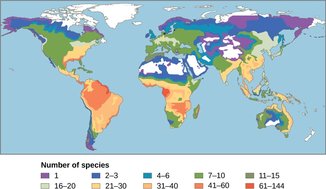 image from https://courses.lumenlearning.com
image from https://courses.lumenlearning.com
It is important to conservation efforts so that areas of high biodiversity are identified, explored, and appropriate conservation practices put in place where possible.
The measurements of biodiversity are essential in identifying areas that should be protected against damaging human activities.
Biodiversity boosts ecosystem productivity where each species, no matter how small, all have an important role to play. For example, A larger number of plant species means a greater variety of crops. Greater species diversity ensures natural sustainability for all life forms.
The measurements of biodiversity are essential in identifying areas that should be protected against damaging human activities.
Biodiversity boosts ecosystem productivity where each species, no matter how small, all have an important role to play. For example, A larger number of plant species means a greater variety of crops. Greater species diversity ensures natural sustainability for all life forms.
Key Terms
|
biodiversity
stability biodiversity hotspot |
genetic diversity
species diversity |
species diversity
habitat simpson index |
habitat diversity
lithosphere resilience |
population
gene pool |
Classroom Materials
Biodiversity and Conservation Project
Consequence of Change Article
Island Foxes May be 'Least Variable' of all Wild Animals Article
Case Studies
Speciation of Camels
Speciation of Spotted Owls
Biodiversity and Conservation Project
Consequence of Change Article
Island Foxes May be 'Least Variable' of all Wild Animals Article
Case Studies
- Examples of speciation of an organism
Speciation of Camels
Speciation of Spotted Owls
Powerpoint and Notes Adapted from Brad Kremer, P Brooks and Ms. McCrindle
Your browser does not support viewing this document. Click here to download the document.
Your browser does not support viewing this document. Click here to download the document.
Correct use of terminology is a key skill in ESS. It is essential to use key terms correctly when communicating your understanding, particularly in assessments. Use the quizlet flashcards or other tools such as learn, scatter, space race, speller and test to help you master the vocabulary.
Useful Links
Science Sauce Topic 3.1 Biodiversity
Map Maker: Biodiversity Hotspots
National Geographic: Types of Biodiversity
NWF Why is Diversity Important?
Natural History Museum site
Global Issues with Biodiversity - Global Issues
Biodiversity Science
Island Biogeography from Stanford University, USA
Another good island biogeography animation showing the physical migration, real-time data, and a graph.
Biodiversity and Ecosystem Stability - Nature
Millennium seed bank
In The News
Global Biodiversity Outlook - Convention on Biological Diversity
TOK
- The term "biodiversity" has replaced the term" nature" in much literature on conservation issues-does this represent a paradigm shift?
- Diversity index is not a measure in the true sense of a word, but merely a number (index) s it involves a subjective judgment on the combination of two measures: proportion and richness. Are there examples in other areas of knowledge of the subjective use of numbers?
International Mindedness
- International scientific collaboration is important in the conservation of biodiverse regions.
Video Clips
Convention on Biological Diversity
Convention on Biological Diversity
Why biodiversity is so important
Are all coral reefs the same? Each regional ecosystem has its own assemblage of species and each contributes uniquely to global biodiversity. Explore why ecosystem diversity is important for conservation decisions
The Socotra archipelago in the Arabian Sea supports so many diverse and unique species that it has been described as the most alien place on Earth. Hank takes you on a tour of this weird place in this episode of SciShow.
Genetic technologies can be helpful conservation tools, particularly when they help us better monitor the species we are trying to preserve, but they are no substitute for protecting habitats
Paul Andersen explains the importance of genetic variation within a population.
How does the gene pool contribute to biodiversity? Learn how genetic diversity within populations contributes to species survival.
